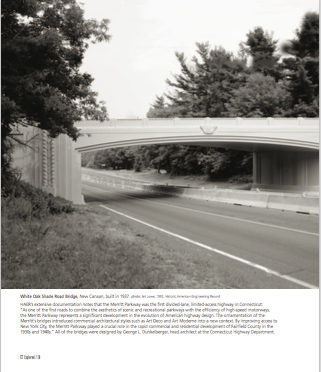By Mary M. Donohue with Bruce Clouette
(c) Connecticut Explored Inc. SUMMER 2015
Subscribe/Buy the Issue!
“Some were suggesting the Hudson,” [Billy] Joel told Hartford Courant reporter Roger Catlin in 1993. “But, I said, No, no, no. The Connecticut River has much more in a shorter span.… You have urban, and you have New England and you have bucolic and you have an ocean.”
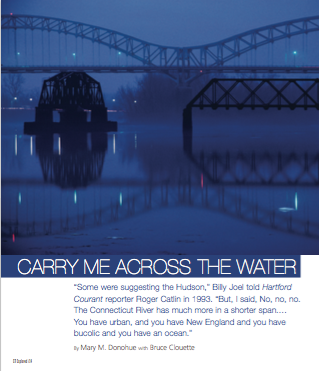 Pop musician Billy Joel chose Connecticut as the location to film the music video for the Grammy-nominated title track from his five-time platinum 1993 album The River of Dreams. The video is full of recognizable Connecticut scenes: a tobacco barn, the Portland brownstone quarry, and the sign along the Portland riverbank that invites people to “Come on Over.”
Pop musician Billy Joel chose Connecticut as the location to film the music video for the Grammy-nominated title track from his five-time platinum 1993 album The River of Dreams. The video is full of recognizable Connecticut scenes: a tobacco barn, the Portland brownstone quarry, and the sign along the Portland riverbank that invites people to “Come on Over.”
But the Providence & Worcester Railroad Bridge in Middletown is the star. The structure makes a strong statement when seen against the more dream-like images of water. In several shots, Joel stands in front of three backup singers on rough wooden planks placed over the railroad tracks with the riveted steel bridge trusses and the operator’s cab visible behind them. Built in 1911, the bridge is a Warren through-truss swing bridge with an overall length of 1,142 feet. The center span rotates to allow vessels to pass through on their way north to Hartford.
Historic bridges often become iconic landmarks in their communities. They embody the development of American technology. Some are marvels of civil engineering, some are as sculptural as a piece of art, and some are everyday reminders of a sense of place. As historic preservationists began to move beyond the preservation of a single building in the 1960s and see the interconnectedness of elements within the built environment, historic bridges of all kinds began to attract both scholarly interest and that of the general public.
Construction Materials
Connecticut’s first bridges were built with stone and wood; iron and steel came into use in the late 19th century, and concrete in the 20th century. Early Connecticut bridges were often short spans built of wood. Some later became “covered bridges” when the bridge’s structural members were protected from rain and snow by a roof. Connecticut can claim two early covered-bridge builders of note. According to Donald Jackson in Great American Bridges and Dams (The Preservation Press, 1988) Theodore Burr (1771-1822) developed the Burr arch truss and patented his design in 1817. New Haven’s Ithiel Town (1784-1844) patented his Town lattice in 1829 —a popular wooden bridge design that resisted sagging. In the late 1800s, iron and steel replaced wood in bridge construction. As Bruce Clouette and Matthew Roth note in Connecticut’s Historic Highway Bridges (Connecticut Department of Transportation, 1991), “Fabricators such as Connecticut’s Berlin Iron Bridge Company bought iron in basic forms—I-beams, angle, plates—and cut and riveted it together to make bridge components. The companies employed traveling agents to sell their products to local highway officials.” The company was bought in 1900 by Hartford-born banker and industrialist J. P. Morgan to form part of his American Bridge Company. Stone arch bridges in the state range from small single spans to Hartford’s monumental Bulkeley Bridge, built from 1906 to 1908. Steel and concrete bridges of the 20th century include such marvels as the steel Arrigoni Bridge, built from 1936 to 1938 in Middletown, and the reinforced-concrete bridges of the Merritt Parkway, built from 1938 to 1940.
Historic bridge advocates face the challenge of balancing modern transportation needs with saving the legacy of bridges built during the last 150 years. The preservation of historic bridges can take many forms. Ideally, bridges can be left in place by either rehabilitating them to meet modern requirements or by repurposing them as hiking trails/bikeways. Relocating bridges is sometimes an option. Research, education, and advocacy are essential to increasing public appreciation and support for saving historic bridges.
Historic American Engineering Record
More than 45 Connecticut bridges have been listed on the National Register of Historic Places. In addition to the National Register program, the National Park Service of the U.S. Department of the Interior administers the Historic American Engineering Record (HAER), which was created in 1969 to document the nation’s engineering and industrial landmarks. The images in the pages that follow are from the HAER collection and Hartford architectural photographer Robert Benson. As you travel the state this summer, be on the lookout for these icons.
Unless otherwise noted, the caption information is from two volumes published by the Connecticut Department of Transportation: Bruce Clouette and Matthew Roth, Connecticut’s Historic Highway Bridges (1991) and Bruce Clouette, Where Water Meets Land: Movable Bridges in Connecticut (2004).
Mary M. Donohue is an architectural historian and the assistant publisher of Connecticut Explored. She chaired the Summer 2015 issue.
Bruce Clouette is the director of historical research at Archaeological and Historical Services, Inc.
Above: Providence & Worcester Railroad Bridge (foreground) built in 1911 for the former Air Line rail route, and the Charles J. Arrigoni Bridge (background), Routes 66 and 17, built 1936−1938, both over the Connecticut River, Middletown–Portland. The Arrigoni Bridge is a steel through arch, 3,428 feet overall length, Leslie G. Sumner, Connecticut State Highway Department and William G. Grove, the American Bridge Company, designers; fabricated by the Bethlehem Steel Company. photo: Robert Benson, 1993
A high arch bridge that allows ships to pass underneath unobstructed, the Arrigoni Bridge was the most expensive bridge built in the state before 1938 and the 1938 winner of the American Institute of Steel Construction’s First Prize in the large-bridge category.
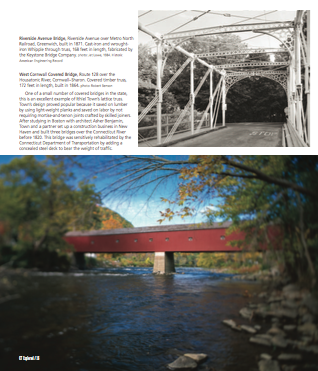 Riverside Avenue Bridge, Riverside Avenue over Metro North Railroad, Greenwich, built in 1871. Cast-iron and wrought-iron Whipple through truss, 168 feet in length, fabricated by the Keystone Bridge Company. photo: Jet Lowe, 1984. Historic American Engineering Record
Riverside Avenue Bridge, Riverside Avenue over Metro North Railroad, Greenwich, built in 1871. Cast-iron and wrought-iron Whipple through truss, 168 feet in length, fabricated by the Keystone Bridge Company. photo: Jet Lowe, 1984. Historic American Engineering Record
West Cornwall Covered Bridge, Route 128 over the Housatonic River, Cornwall−Sharon. Covered timber truss, 172 feet in length, built in 1864. photo: Robert Benson
One of a small number of covered bridges in the state, this is an excellent example of Ithiel Town’s lattice truss. Town’s design proved popular because it saved on lumber by using light-weight planks and saved on labor by not requiring mortise-and-tenon joints crafted by skilled joiners. After studying in Boston with architect Asher Benjamin, Town and a partner set up a construction business in New Haven and built three bridges over the Connecticut River before 1820. This bridge was sensitively rehabilitated by the Connecticut Department of Transportation by adding a concealed steel deck to bear the weight of traffic.
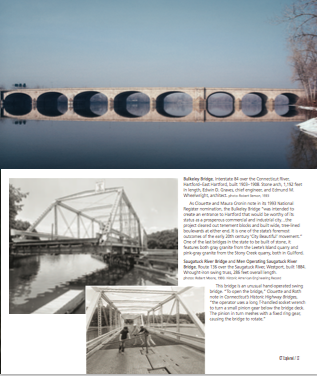 Bulkeley Bridge, Interstate 84 over the Connecticut River, Hartford−East Hartford, built 1903−1908. Stone arch, 1,192 feet in length, Edwin D. Graves, chief engineer and Edmund M. Wheelwright, architect. photo: Robert Benson, 1993
Bulkeley Bridge, Interstate 84 over the Connecticut River, Hartford−East Hartford, built 1903−1908. Stone arch, 1,192 feet in length, Edwin D. Graves, chief engineer and Edmund M. Wheelwright, architect. photo: Robert Benson, 1993
As Clouette and Maura Cronin note in its 1993 National Register nomination, the Bulkeley Bridge “was intended to create an entrance to Hartford that would be worthy of its status as a prosperous commercial and industrial city…the project cleared out tenement blocks and built wide, tree-lined boulevards at either end. It is one of the state’s foremost outcomes of the early 20th century ‘City Beautiful’ movement.” One of the last bridges in the state to be built of stone, it features both gray granite from the Leete’s Island quarry and pink-gray granite from the Stony Creek quarry, both in Guilford.
Saugatuck River Bridge, Route 136 over the Saugatuck River, Westport, built 1884. Wrought-iron swing truss, 286 feet overall length. photo: Robert Moore, 1990. Historic American Engineering Record
Men Operating Saugatuck River Bridge. photo: Robert Moore,1990. Historic American Engineering Record
This bridge is an unusual hand-operated swing bridge. “To open the bridge,” Clouette and Roth note in Connecticut’s Historic Highway Bridges, “the operator uses a long T-handled socket wrench to turn a small pinion gear below the bridge deck. The pinion in turn meshes with a fixed ring gear, causing the bridge to rotate.”
HAER’s extensive documentation notes that the Merritt Parkway was the first divided-lane, limited-access highway in Connecticut: “As one of the first roads to combine the aesthetics of scenic and recreational parkways with the efficiency of high-speed motorways, the Merritt Parkway represents a significant development in the evolution of American highway design. The ornamentation of the Merritt’s bridges introduced commercial architectural styles such as Art Deco and Art Moderne into a new context. By improving access to New York City, the Merritt Parkway played a crucial role in the rapid commercial and residential development of Fairfield County in the 1930s and 1940s.” All of the bridges were designed by George L. Dunkelberger, head architect at the Connecticut Highway Department.
White Oak Shade Road Bridge, New Canaan, built in 1937. photo: Jet Lowe, 1992. Historic American Engineering Record
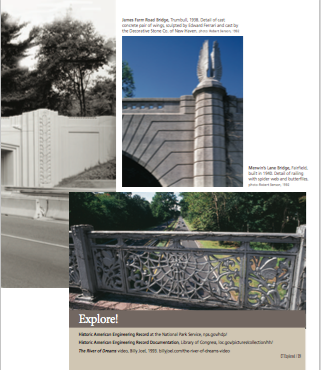 James Farm Road Bridge, Trumbull, 1938. Detail of cast concrete pair of wings, sculpted by Edward Ferrari and cast by the Decorative Stone Co. of New Haven. photo: Robert Benson, 1992
James Farm Road Bridge, Trumbull, 1938. Detail of cast concrete pair of wings, sculpted by Edward Ferrari and cast by the Decorative Stone Co. of New Haven. photo: Robert Benson, 1992
Merwin’s Lane Bridge, Fairfield, built in 1940. Detail of railing with spider web and butterflies. photo: Robert Benson, 1992
Explore!
Historic American Engineering Record at the National Park Service, nps.gov/hdp/
Historic American Engineering Record Documentation, Library of Congress, loc.gov/pictures/collection/hh/
Read all of our historic preservation stories on out TOPICS page
Read all of our stories about travel & transportation by clicking on the category at the top of the page
The River of Dreams video, Billy Joel, 1993. billyjoel.com/the-river-of-dreams-video

